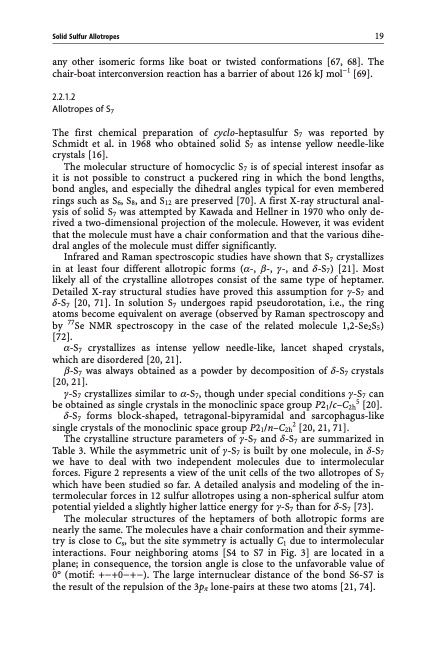
PDF Publication Title:
Text from PDF Page: 029
Solid Sulfur Allotropes 19 any other isomeric forms like boat or twisted conformations [67, 68]. The chair-boat interconversion reaction has a barrier of about 126 kJ mol1 [69]. 2.2.1.2 Allotropes of S7 The first chemical preparation of cyclo-heptasulfur S7 was reported by Schmidt et al. in 1968 who obtained solid S7 as intense yellow needle-like crystals [16]. The molecular structure of homocyclic S7 is of special interest insofar as it is not possible to construct a puckered ring in which the bond lengths, bond angles, and especially the dihedral angles typical for even membered rings such as S6, S8, and S12 are preserved [70]. A first X-ray structural anal- ysis of solid S7 was attempted by Kawada and Hellner in 1970 who only de- rived a two-dimensional projection of the molecule. However, it was evident that the molecule must have a chair conformation and that the various dihe- dral angles of the molecule must differ significantly. Infrared and Raman spectroscopic studies have shown that S7 crystallizes in at least four different allotropic forms (a-, b-, g-, and d-S7) [21]. Most likely all of the crystalline allotropes consist of the same type of heptamer. Detailed X-ray structural studies have proved this assumption for g-S7 and d-S7 [20, 71]. In solution S7 undergoes rapid pseudorotation, i.e., the ring atoms become equivalent on average (observed by Raman spectroscopy and by 77Se NMR spectroscopy in the case of the related molecule 1,2-Se2S5) [72]. a-S7 crystallizes as intense yellow needle-like, lancet shaped crystals, which are disordered [20, 21]. b-S7 was always obtained as a powder by decomposition of d-S7 crystals [20, 21]. g-S7 crystallizes similar to a-S7, though under special conditions g-S7 can be obtained as single crystals in the monoclinic space group P21/c–C2h5 [20]. d-S7 forms block-shaped, tetragonal-bipyramidal and sarcophagus-like single crystals of the monoclinic space group P21/n–C2h2 [20, 21, 71]. The crystalline structure parameters of g-S7 and d-S7 are summarized in Table 3. While the asymmetric unit of g-S7 is built by one molecule, in d-S7 we have to deal with two independent molecules due to intermolecular forces. Figure 2 represents a view of the unit cells of the two allotropes of S7 which have been studied so far. A detailed analysis and modeling of the in- termolecular forces in 12 sulfur allotropes using a non-spherical sulfur atom potential yielded a slightly higher lattice energy for g-S7 than for d-S7 [73]. The molecular structures of the heptamers of both allotropic forms are nearly the same. The molecules have a chair conformation and their symme- try is close to Cs, but the site symmetry is actually C1 due to intermolecular interactions. Four neighboring atoms [S4 to S7 in Fig. 3] are located in a plane; in consequence, the torsion angle is close to the unfavorable value of 0 (motif: ++0+). The large internuclear distance of the bond S6-S7 is the result of the repulsion of the 3pp lone-pairs at these two atoms [21, 74].PDF Image | Topics in Current Chemistry

PDF Search Title:
Topics in Current ChemistryOriginal File Name Searched:
Elemental-Sulfur-und-Sulfur-Rich-Compounds-I.pdfDIY PDF Search: Google It | Yahoo | Bing
Sulfur Deposition on Carbon Nanofibers using Supercritical CO2 Sulfur Deposition on Carbon Nanofibers using Supercritical CO2. Gamma sulfur also known as mother of pearl sulfur and nacreous sulfur... More Info
CO2 Organic Rankine Cycle Experimenter Platform The supercritical CO2 phase change system is both a heat pump and organic rankine cycle which can be used for those purposes and as a supercritical extractor for advanced subcritical and supercritical extraction technology. Uses include producing nanoparticles, precious metal CO2 extraction, lithium battery recycling, and other applications... More Info
| CONTACT TEL: 608-238-6001 Email: greg@infinityturbine.com | RSS | AMP |